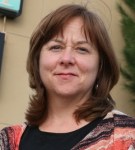Kamilla Benko spent most of her childhood climbing into wardrobes, trying to step through mirrors, and plotting to run away to an art museum. Now, she visits other worlds as a children’s book editor. Originally from Indiana, she currently lives in New York with her bookshelves, teapot, and hiking boots.
She describes her magical new MG this way:
Claire Martinson still worries about her older sister Sophie, who battled a mysterious illness last year. But things are back to normal as they move into Windermere Manor… until the sisters climb a strange ladder in a fireplace and enter the magical land of Arden.
There, they find a world in turmoil. The four guilds of magic no longer trust each other. The beloved unicorns have gone, and terrible wraiths roam freely. Scared, the girls return home. But when Sophie vanishes, it will take all of Claire’s courage to climb back up the ladder, find her sister, and uncover the unicorns’ greatest secret.
Kamilla dropped by the MUF to give us a sneak peek into her writing process (spoiler alert: it’s not always easy!)
A fresh page.
A blank expanse with no mistakes, just waiting for your perfect idea to stampede across it, in wild curly cues of insight (or straight backed letters, if you’re typing and not one for cursive.) It’s exciting! It’s exhilarating! And then…
The words don’t come.
My solution had been, for years, to immediately close the blank Word document and go back to watching Downton Abbey with my cat. It was a reasonable enough solution and I learned a lot about the inner workings of a Victorian era high society house, which I’m sure will help me with my writing… some day!
I find myself thinking that the worst part of the blank page is not having no ideas, but having far too many. It’s imagination in its purest form. And here I am caught with the paradox of choice. It’s the same disorder that causes you to scroll through your Netflix queue for hours at a time wondering why you don’t want to watch a single TV show. It’s because there are thousands of choices and you are suddenly crippled by the choice of having to pick only one (commitment issues, anyone?).
And because this paradox of choice has caused so many smart, talented writers to stop dead in their tracks, I want to share a few ways I worked through the terror of the blank page. These are few tips on how I, for the moment, tackled the infamous conundrum of Writer’s Block while working on my debut novel, The Unicorn Quest.
Tip Number One: Look AWAY!
Don’t turn on Downton Abbey, but do play with your cat. Take a walk, either on the sidewalk or through the mysterious side streets of the internet. Start putting together a Pinterest for each of your projects. Go to a Museum. Get lost on a street you’ve never turned down. Put on some music and go to a park. I’m in New York, so I like to put on some timeless music and wander through Central Park until I can almost forget what year it is. Let yourself be transported by the beauty of what is around you. Make sure to get yourself out of your house or apartment, and find something new.
Tip Number Two: READ!
This should be obvious, but sometimes it’s not. Why would you want to be a writer if you aren’t a voracious reader? I know some authors avoid reading during writing projects, as they are too worried about being influenced by other works. This is not a philosophy I prescribe to. Don’t be a copy cat, obviously, but your brain is unique enough to take in other works and craft your own narratives from those interpretations.
And don’t read just what connects to your book! Read books about politics, history, memoirs. Read about great historical romances and long lost civilizations and explorers discovering new lands – even if you’re writing a contemporary love story set in New York City. I truly believe it is human nature to search for patterns, and your brain will start making new and fascinating connections between disparate sources.
Tip Three: Give yourself permission to FAIL.
I’m going to be upfront with you. You’re going to write a lot of bad stuff. Tons of totally bad, awful, no good writing. And you know who else wrote a lot of bad stuff? J.K. Rowling, J.R.R. Tolkien, probably even William Shakespeare. One of the best pieces of advice I ever received on writing is this: When you first start writing, you will want to quit because your writing won’t be good enough to match your taste. You just have to keep writing until you are good enough to create something you actually like.
Sometimes, you just need to wade into the blankness of the page and give yourself permission to just be bad. Be cliché and be silly! You’ll find that, magically, gems appear on the page in between. One of the best ways to dive into this is to assign yourself a time to free write. This means writing for 15 minutes straight without ever taking your fingers off the keyboard or lifting your pencil from the page. There’s even an app for this. It lets you set a timer for yourself and if you stop writing, it deletes your previous progress. You have to keep writing! Always remember that things are almost never perfect on the first try.
Thanks, Kamilla! And thanks for offering a free copy of The Unicorn Quest to one lucky winner. To be eligible, please enter a comment below.
.



 Welcome to
Welcome to 

 Your host this week is
Your host this week is 
